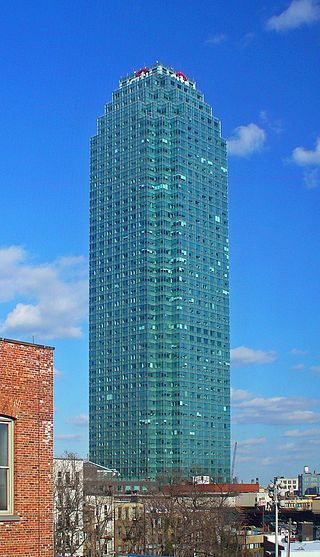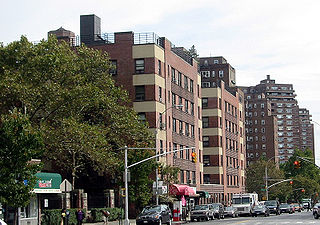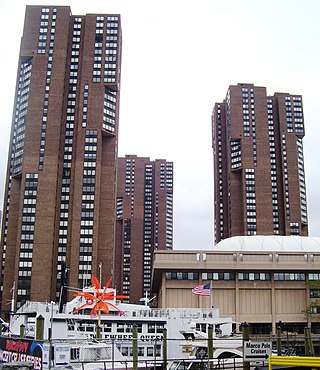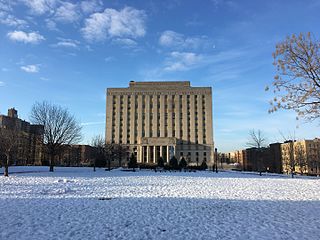
East Harlem, also known as Spanish Harlem or El Barrio, is a neighborhood of Upper Manhattan in New York City, north of the Upper East Side and bounded by 96th Street to the south, Fifth Avenue to the west, and the East and Harlem Rivers to the east and north. Despite its name, it is generally not considered to be a part of Harlem proper, but it is one of the neighborhoods included in Greater Harlem.

Co-op City is a cooperative housing development located in the northeast section of the borough of the Bronx in New York City. It is bounded by Interstate 95 to the southwest, west, and north and the Hutchinson River Parkway to the east and southeast, and is partially in the Baychester and Eastchester neighborhoods. With 43,752 residents as of the 2010 United States Census, it is the largest housing cooperative in the world. It is in New York City Council District 12.

The New York City Housing Authority (NYCHA) is a public development corporation which provides public housing in New York City, and is the largest public housing authority in North America. Created in 1934 as the first agency of its kind in the United States, it aims to provide decent, affordable housing for low- and moderate-income New Yorkers throughout the five boroughs of New York City. NYCHA also administers a citywide Section 8 Leased Housing Program in rental apartments. NYCHA developments include single and double family houses, apartment units, singular floors, and shared small building units, and commonly have large income disparities with their respective surrounding neighborhood or community. These developments, particularly those including large-scale apartment buildings, are often referred to in popular culture as "projects."

One Court Square, also known as the Citicorp Building or the Citigroup Building, is a 50-story, 673-foot (205 m) office tower in Long Island City, Queens, across the East River from Manhattan in New York City, United States. It was completed in 1989 and designed by Skidmore, Owings & Merrill for Citigroup. The building was the tallest in Queens from its completion until the topping out of Skyline Tower in 2019, and for many years was the only skyscraper in Long Island City. It is now home to telecommunications firm Altice USA, whose logo adorns the top of the building, among other tenants.

Castle Hill is a neighborhood located in the southeast section of the borough of the Bronx in New York City. Its boundaries are Waterbury Avenue and Westchester Avenue to the north, Westchester Creek to the east, the East River to the south, and White Plains Road to the west. Unionport is a subsection of Castle Hill, typically considered north of Lafayette Avenue.

The Mitchell–Lama Housing Program is a non-subsidy governmental housing guarantee in the state of New York. It was sponsored by New York State Senator MacNeil Mitchell and Assemblyman Alfred A. Lama. It was signed into law in 1955 as The Limited-Profit Housing Companies Act.

Cooperative Village is a community of housing cooperatives on the Lower East Side of Manhattan, New York City. The cooperatives are centered on Grand Street in an area south of the entrance ramp to the Williamsburg Bridge and west of the FDR Drive. Combined, the four cooperatives have 4,500 apartments in twelve buildings.

The Riverton Houses is a large residential development in Harlem, Manhattan, New York City.

Penn South, officially known as Mutual Redevelopment Houses and formerly Penn Station South, is a limited-equity housing cooperative development located between Eighth and Ninth Avenues and West 23rd and 29th Streets, in the Chelsea neighborhood of Manhattan in New York City. The complex has 2,820 units in ten 22-story buildings. Penn South is so named because of its location southwest of New York Penn Station.

Waterside Plaza is a residential and business complex located on the East River in the Kips Bay section of Manhattan, New York City. It was formerly a Mitchell-Lama Housing Program-funded rental project.

3333 Broadway is a group of five apartment buildings ranging from 11 to 35 stories at Broadway between West 133rd and 135th Streets, in Manhattanville, Manhattan, New York City, United States. Completed in 1976, it was the largest residential structure in the United States. Together, the five buildings include 1,193 apartment units. The present manager of the property is the Urban American Management Corporation.

1520 Sedgwick Avenue is a 102-unit apartment building in the Morris Heights neighborhood of the Bronx in New York City. Described in The New York Times as a long-time "haven for working class families", it has been historically accepted as the birthplace of hip hop.

The East River Greenway is an approximately 9.44-mile-long (15.19 km) foreshoreway for walking or cycling on the east side of the island of Manhattan on the East River. It is part of the Manhattan Waterfront Greenway. The largest portions are operated by the New York City Department of Parks and Recreation. It is separated from motor traffic, and many sections also separate pedestrians from cyclists. The greenway is parallel to the Franklin D. Roosevelt East River Drive for a majority of its length.
Laurence Gluck is an American New York-based real estate investor, landlord, and the founder of the real estate company Stellar Management.
Trump Parc and Trump Parc East are two adjoining buildings at the southwest corner of Central Park South and Sixth Avenue in Midtown Manhattan, New York City. Trump Parc is a 38-story condominium building, and Trump Parc East is a 14-story apartment and condominium building.

Concourse is a neighborhood in the southwestern section of the New York City borough of the Bronx which includes the Bronx County Courthouse, the Bronx Museum of the Arts, and Yankee Stadium. Its boundaries, starting from the north and moving clockwise, are East 169th Street to the north, Webster Avenue to the east, East 149th Street to the south, and Jerome Avenue and Harlem River to the west. The neighborhood is divided into three subsections: West Concourse, East Concourse, and Concourse Village with the Grand Concourse being its main thoroughfare.

Tracey Towers refers to two twin buildings designed by architect Paul Rudolph, located in the Jerome Park neighborhood of the Bronx, New York City. They are a predominant feature of the Bronx's mainly flat skyline.
Twin Parks is a housing development in the Bronx, New York City. Its buildings were designed by leading architects, and were widely hailed as "the cutting edge of public design" when constructed in the early 1970s.















